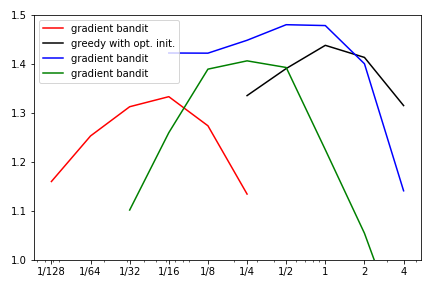Parameter study and recreation of figure 2.6.
Helper functions
In [1]:
def argmax_rand(arr):
# break ties randomly, np.argmax() always picks first max
return np.random.choice(np.flatnonzero(arr == arr.max()))
In [2]:
def softmax(x):
"""Numerically stable softmax"""
ex = np.exp(x - np.max(x))
return ex / np.sum(ex)
Bandit algorithms
In [3]:
def simple_bandit(env, nb, eps):
Q = np.zeros(env.size)
N = np.zeros(env.size)
hist_A = []
hist_R = []
for _ in range(nb):
A = argmax_rand(Q) if np.random.rand() > eps else np.random.randint(env.size)
R = env.step(A)
N[A] += 1
Q[A] += (1/N[A]) * (R - Q[A])
hist_A.append(A)
hist_R.append(R)
return Q, np.array(hist_A), np.array(hist_R)
In [4]:
def tracking_bandit(env, nb, eps, alpha, Q_init):
hist_A = []
hist_R = []
Q = np.zeros(env.size) + Q_init
for _ in range(nb):
A = argmax_rand(Q) if np.random.rand() > eps else np.random.randint(env.size)
R = env.step(A)
Q[A] += alpha * (R - Q[A])
hist_A.append(A)
hist_R.append(R)
return Q, np.array(hist_A), np.array(hist_R)
In [5]:
def ucb_bandit(env, nb, c):
Q = np.zeros(env.size)
N = np.zeros(env.size)
hist_A = []
hist_R = []
# select each action at lest once
for A in range(env.size):
R = env.step(A)
N[A] += 1
Q[A] += (1/N[A]) * (R - Q[A])
hist_A.append(A)
hist_R.append(R)
for t in range(env.size, nb):
A = argmax_rand( Q + c * np.sqrt( np.log(t) / N ) )
R = env.step(A)
N[A] += 1
Q[A] += (1/N[A]) * (R - Q[A])
hist_A.append(A)
hist_R.append(R)
return Q, np.array(hist_A), np.array(hist_R)
In [6]:
def gradient_bandit(env, nb, alpha, baseline):
H = np.zeros(env.size)
R_, N_ = 0.0, 0.0
hist_A = []
hist_R = []
for _ in range(nb):
pi = softmax(H)
A = np.random.choice(range(env.size), p=pi)
R = env.step(A)
H_new = H - alpha*(R-R_)*pi # for all a =/= A
H_new[A] = H[A] + alpha*(R-R_)*(1-pi[A]) # for a == A
H = H_new
if baseline:
N_ += 1
R_ += 1/N_ * (R-R_)
hist_A.append(A)
hist_R.append(R)
return H, np.array(hist_A), np.array(hist_R)
 |
Experiment Setup¶
In [7]:
import numpy as np
import matplotlib.pyplot as plt
import multiprocessing as mp
Environment
In [8]:
class BanditEnv:
def __init__(self):
"""10-armed testbed, see chapter 2.3"""
self.size = 10 # 10 arms
self.offset = 0
self.means = np.random.normal(loc=self.offset, scale=1.0, size=self.size)
def step(self, action):
return np.random.normal(loc=self.means[action])
Recreate Figure 2.6¶
Generate data
In [9]:
def run_single_experiment(algorithm, param):
np.random.seed() # required due to multiprocessing
env = BanditEnv()
if algorithm == 'egreedy_bandit':
_, _, hist_R = simple_bandit(env, nb=1000, eps=param)
elif algorithm == 'greedy_opt_bandit':
_, _, hist_R = tracking_bandit(env, nb=1000, eps=0.0, alpha=0.1, Q_init=param)
elif algorithm == 'ucb_bandit':
_, _, hist_R = ucb_bandit(env, nb=1000, c=param)
elif algorithm == 'gradient_bandit':
_, _, hist_R = gradient_bandit(env, nb=1000, alpha=param, baseline=True)
else:
raise ValueError('Unknown algorithm:', algorithm)
return hist_R.mean() # average over 1000 steps
In [10]:
def run_multiple_exp(repeat, algorithm, param):
with mp.Pool(processes=mp.cpu_count()) as pool:
param_list = [(algorithm, param)] * repeat
results = pool.starmap(run_single_experiment, param_list)
return np.mean(results)
In [11]:
repeat = 2000
In [12]:
egreedy_x, egreedy_y = [], []
for param in [1/128, 1/64, 1/32, 1/16, 1/8, 1/4]:
result = run_multiple_exp(repeat=repeat, algorithm='egreedy_bandit', param=param)
print(f'Running e-greedy, eps={param:.3f}: {result:.3f}')
egreedy_x.append(param)
egreedy_y.append(result)
In [13]:
greedy_opt_x, greedy_opt_y = [], []
for param in [1/4, 1/2, 1, 2, 4]:
result = run_multiple_exp(repeat=2000, algorithm='greedy_opt_bandit', param=param)
print(f'Running greedy with optimistic init., Q_init={param:.3f}: {result:.3f}')
greedy_opt_x.append(param)
greedy_opt_y.append(result)
In [14]:
ucb_x, ucb_y = [], []
for param in [1/16, 1/8, 1/4, 1/2, 1, 2, 4]:
result = run_multiple_exp(repeat=2000, algorithm='ucb_bandit', param=param)
print(f'Running UCB, c={param:.3f}: {result:.3f}')
ucb_x.append(param)
ucb_y.append(result)
In [15]:
gradient_x, gradient_y = [], []
for param in [1/32, 1/16, 1/8, 1/4, 1/2, 1, 2, 4]:
result = run_multiple_exp(repeat=2000, algorithm='gradient_bandit', param=param)
print(f'Running gradient, alpha={param:.3f}: {result:.3f}')
gradient_x.append(param)
gradient_y.append(result)
In [16]:
fig = plt.figure()
ax = fig.add_subplot(111)
ax.plot(egreedy_x, egreedy_y, color='red', label='gradient bandit')
ax.plot(greedy_opt_x, greedy_opt_y, color='black', label='greedy with opt. init.')
ax.plot(ucb_x, ucb_y, color='blue', label='gradient bandit')
ax.plot(gradient_x, gradient_y, color='green', label='gradient bandit')
ax.set_xscale('log')
ax.set_xticks([1/128, 1/64, 1/32, 1/16, 1/8, 1/4, 1/2, 1, 2, 4])
ax.set_xticklabels(['1/128', '1/64', '1/32', '1/16', '1/8', '1/4', '1/2', '1', '2', '4'])
ax.set_ylim((1.0, 1.5))
ax.legend()
plt.tight_layout()
plt.savefig('assets/fig_0206.png')
plt.show()